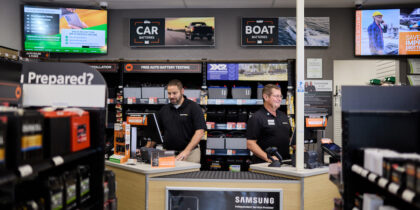So much change, so fast — the role of retail warehouses is shifting rapidly as e-commerce fulfillment, next/same-day delivery and accelerating return rates force new, dramatically different requirements on traditional distribution. Warehouses are under tremendous pressure to up their game in speed, data-driven inventory management and operating efficiency.
Shifting demands make this the perfect time for retailers to take a serious look at upgrading the inventory management system they use to run their distribution operations. Warehouse execution now requires far more communication as well as access to remote, cloud-based data and apps — needs that cannot be accommodated by traditional hand-held scanners.
Learn the value of a new approach to mobile-enriched retail warehouse with these five key reasons to migrate to a mobile inventory platform.
Drive Efficiency
Retail warehouses need mobile devices that are both rugged enough to withstand the rigors of daily operations and versatile enough to adapt to new demands. Rugged mobile devices running a modern OS, such as Samsung phones and tablets running Android on the Knox platform, enable users to easily switch between scanning and communication to boost productivity. Users can also easily access cloud-based apps and data in real time, enabling them to make decisions quickly to keep retail inventory moving.
Joe Vernon, practice leader, supply chain consulting at Capgemini, recently told DC Velocity, “The explosion of consumer-grade interfaces and tools enabled by a next-generation OS could give a shot in the arm to labor productivity in the DC.” Android OS was used in 80 percent of all smartphones worldwide and in 37 percent of rugged devices in 2016, the latter up from 24 percent the year before, according to a report from VDC Research.
Improve ROI
With their fast processors and high-resolution cameras, rugged, unlocked smartphones and tablets can now match, and often exceed, the performance of dedicated scanning devices. These devices not only offer more features and flexibility than traditional scanners, they do so at a lower price point. This is welcome news for retailers as they seek to respond to new warehouse demands with limited resources, supporting a rapid ROI from new devices.
Transform Retail Associate Performance
Get your free guide to empowering retail associates with mobile devices and data. Download Now
According to the VDC Research report, The Global Market for Handheld Barcode Scanners 2018, “The shift to 2D imagers has been significant, and users are concerned about the higher expense price points and are demanding lower cost value alternatives. … As consumer devices like smartphones and tablets reach hundreds of millions of units in circulation, enterprises and small and medium businesses (SMBs) are implementing them as scanning devices as well as using camera capabilities for QR code scanning.”
Know Your Data Is Secure
Retailers are also rushing to replace current warehouse hardware due to Microsoft’s decision to discontinue support for Windows Mobile, which is the OS on many legacy rugged mobile devices. Even if these outdated devices could answer demands for additional functionality, the lack of patches and support make them a big security risk.
Fully supported operating systems are just one layer of an effective security strategy to protect against a rising tide of attacks on retail systems. Other key elements include defense-grade security built into both hardware and software layers and advanced authentication such as iris and fingerprint scanning, which enable workers to quickly log on and get to work while offering stronger protection than password-based systems.
According to a report in Modern Materials Handling, increased focus on mobile security, privacy and biometrics are among the top 10 trends in warehouse/DC operations. Retail is a favorite target; three in four retailers have experienced at least one data breach, according to Thales 2018 Data Threat Report, Retail Edition.
Simplify Training
Over the next three years, a significant 56 percent of warehouses plan to increase their use of Android, according to ARC Research and DC Velocity. One big driver is the familiarity of the OS to workers, since Android is used in more than 85 percent of smartphones worldwide.
A familiar operating system makes training faster and easier, a particular benefit as retailers ramp up warehouse staff for seasonal surges. A large percentage of those workers are likely to be millennials. According to Tech Target, millennials and other incoming generations expect to get up and running on software with minimal to no training. “Millennials want to work in organizations that are reflective of their thought processes and paradigms,” he explained. “There is an expectation of having immediacy of information available for whatever they need to do.” Offering familiar tools also boosts recruitment efforts.
Empower Store Managers
Traditional store management solutions deliver all of their management and reporting functions on the desktop, tethering managers to their desks. But now, Gartner VP Dwight Klappish says, warehouse software developers are writing more applications that free managers from the desktop so they can use mobile devices to access alerts, analytics and an overview of what’s going on in the warehouse.
Rugged smartphones and tablets enable managers to boost their productivity through features that not only provide mobile access to data, reporting and tools, but enable easy communication and collaboration. When managers need more real estate, a device like the Galaxy Note9 can use the power of Samsung DeX to deliver a desktop-like interface — it can be easily connected to a keyboard, monitor and mouse.
Keeping up with fast-evolving demands means retailers need a mobile inventory management system that delivers efficiency, ROI, security, easy training and manager empowerment.
Learn how you can improve retail associate performance with data and mobile devices.





